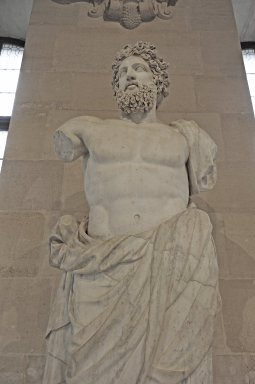Detail View: Archivision Base to Module 9: Bearded Divinity called 'Jupiter of Versailles'

|
Preferred Title:
|
Bearded Divinity called 'Jupiter of Versailles'
|
|
Alternate Title:
|
Buste de divinité barbue, dit Jupiter de Versailles
|
|
Image View:
|
Upper half with drapery added in 17th century
|
|
Creator:
|
unknown (Ancient Roman)
|
|
Location:
|
repository: Musée du Louvre (Paris, Île-de-France, France)
|
|
GPS:
|
+48.861045+2.335787
|
|
Date:
|
2nd century CE (bust) (creation); ca. 1683 (base and drapery) (alteration)
|
|
Cultural Context:
|
Ancient Roman
|
|
Style Period:
|
Imperial (Roman); Seventeenth century
|
|
Work Type 1:
|
sculpture (visual work)
|
|
Work Type 2:
|
herm
|
|
Classification:
|
sculpture
|
|
Material:
|
marble
|
|
Technique:
|
carving (processes)
|
|
Description:
|
The colossal bust was discovered in 1525 near the Porta del Popolo (the ancient Porta Flaminia in the Aurelian Walls of Rome) and moved by Pope Clement VII [Giulio de? Medici] to his villa, Villa Madama. Later given to Margaret, Duchess of Parma and Florence (the illegitimate daughter of Charles V), who in turn gave it to Charles' advisor Nicolas Perrenot de Granvelle (1486-1550). He installed it in the Palais Granvelle in Besançon. It was given to Louis XIV in 1683, at which point it was mounted on a pedestal and the stone drapery was added to smooth the transition and give it a herm-like form. (Source: Louvre Museum [website]; http://www.louvre.fr/)
|
|
Collection:
|
Archivision Addition Module Eight
|
|
Identifier:
|
7A3-R-L-BD-A02
|
|
Rights:
|
© Scott Gilchrist, Archivision, Inc.
|